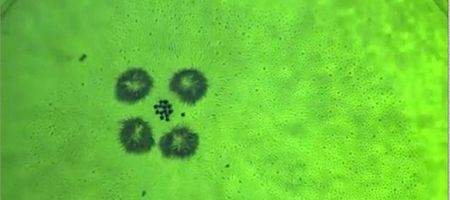Physicists at the US Department of Energy’s (DOE) Argonne National Laboratory have created tiny ‘micro-robots’ that can team up to form an assembly line.

The robots, just half a millimeter wide, are composed of microparticles. Confined between two liquids, they assemble themselves into star shapes when an alternating magnetic field is applied.
Alexey Snezhko and Igor Aronson say they can control the robots’ movement to make them pick up, transport and put down other non-magnetic particles — potentially enabling functional materials to be built in new ways.
Without the magnetic field, the particles drift aimlessly or clump together. With it, though, they self-assemble into spiky circular shapes that the scientists nicknamed ‘asters’, because of their respemblance to the flower.
Left to their own devices, the asters don’t swim. “But if you apply a second small magnetic field parallel to the surface, they begin to move,” says Aronson. “The field breaks the symmetry of the asters’ hydrodynamic flow, and the asters begin to swim.”
By changing the magnetic field, the researchers discovered they could remotely control the asters’ motion.
“We can make them open their jaws and close them,” says Snezhko. “This gives us the opportunity to use these creatures as mini-robots performing useful tasks. You can move them around and pick up and drop objects.”
They soon discovered that the asters form in two ‘flavors’ – one whose flow circulates in toward the center of the aster, with the other circulating outward.
This means scientists can play the flows against one other to make the asters perform tasks such as acting like a miniature vacuum cleaner to collect free-floating particles.
The asters can pick up objects much larger than themselves.
“They can exert very small forces on objects, which is a big challenge for robotics,” Aronson explained. “Gripping fragile objects without smashing them has always been difficult for conventional robots.”
The materials can even self-repair; if particles are lost, the aster simply re-shuffles itself.
“For us, this is very exciting. This is a new paradigm for reconfigurable self-assembled materials that can perform useful functions,” says Aronson.






